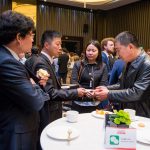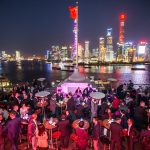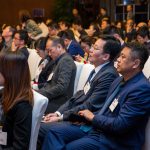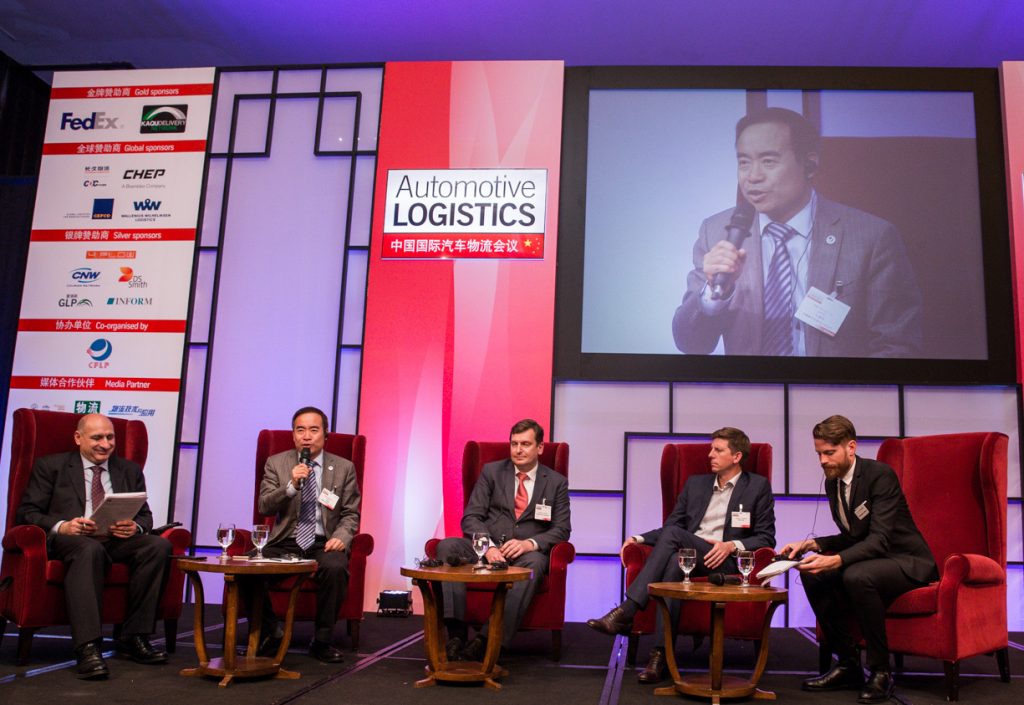
The Chinese automotive industry continues to climb to new heights both in quantity of volume and in quality of service. After a red-hot year for sales and production in 2016 – which rose nearly 15% compared to 2015 to around 28m passenger and commercial vehicles – most analysts and experts expect continued, steady growth well into the next decade. Official forecasts from government agencies, including the State Information Centre, as well as industry associations, such as the China Federation of Logistics and Purchasing (CFLP), predict sales will reach a staggering 40m units by 2025.
In this report
Plants and suppliers are expected to match this product development with their own gains, as increasing labour and real estate costs must be offset by increases in productivity.
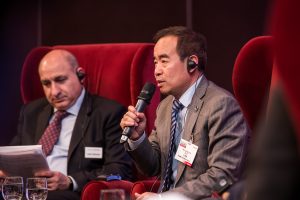 CFLP's Ma Zengrong predicted a competitive, greener future for Chinese automotive logistics
CFLP's Ma Zengrong predicted a competitive, greener future for Chinese automotive logisticsAll of these developments will have significant implications for Chinese automotive logistics. In the short term, the growing market requires more optimised supply chain networks to improve delivery costs and reduce inventories; ongoing changes in legal truck dimensions and loading rules are also forcing companies to adapt transport equipment and use more multimodal transport modes to cope. In the longer term, however, it could mean more significant use of automation and new technology across the supply chain.
[sta_anchor id="1"]Transforming China by 2025?Many observers in China expect this transformation to be a positive one. Ma Zengrong, executive vice-president of CFLP, told delegates at the 2017 Automotive Logistics China conference in Shanghai that by 2025, the automotive industry and supply chain in China would be greener, more competitive and with a more comprehensive logistics systems in place, including for multimodal logistics. “The industry will be more efficient, cleaner and profitable,” he said.
“We anticipate a supply chain with more transparency, accuracy and reliability,” he said. “We hope it will leave us with more time and we will have fewer exceptions to manage.”
Carmakers such as SAIC General Motors (SGM) and Geely-owned Volvo Cars are also pointing the way towards more advanced manufacturing and automation – targets that are in line with the Chinese government’s 13th five-year plan, which was published last year. SGM’s Ni Bin, business development manager for production control and logistics, revealed how the joint venture carmaker is already studying plans to automate and digitise the supply chain in the coming years.
Volvo Cars, meanwhile, also expects to see China develop into a significant market and production centre, including exports to Asia but also to the US and Europe – flows for which sources say the carmaker is going to use long-distance rail services to reach European markets (Volvo has yet to confirm this plan officially). Volvo has also said that it will build its first all-electric vehicle in China.
Magnus Ödling, director of inbound logistics for Asia Pacific and China at Volvo Car Group, said he expected significant developments in technology to be evident in China, including for alternative fuel and autonomous vehicles. He also expected a big rise in localisation across the supply chain.
“That will change our focus in inbound logistics. Today we talk about around 70% local, with a large share coming from Europe and abroad. By 2025, I expect we will be close to 100% for a larger number of vehicles built.”
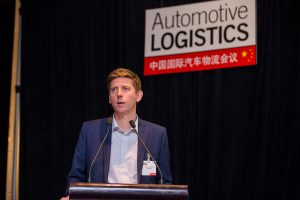 Magnus Ödling pointed to developments in vehicle technology and exports as having big impacts on Volvo's logistics in China
Magnus Ödling pointed to developments in vehicle technology and exports as having big impacts on Volvo's logistics in ChinaOther executives at manufacturers and logistics providers pointed to further developments that ranged from a strong rise in vehicle personalisation and customisation, as well as the potential modularisation of vehicle products and production – especially if there is a big rise in electric vehicles. Michael Bian, logistics manager for spare parts in Asia Pacific at Tesla, for example, suggested that the automotive and high-tech supply chain could continue to merge. As with Tesla already to some degree, cars (as a piece of hardware) could become less complex, even as the software and technology that goes into them becomes more significant.
Ödling suggested that Volvo was soon going to get a sense of what such changes could mean as it prepares to build its first electric model, including the impact on the bill of materials, supplier locations, as well as regulatory compliance and challenges – such as around the movement of hazardous or dangerous materials.
On the sales side, there was even some question over whether the dealers would remain the main centre point for selling and servicing vehicles, especially given the rapid shift to ecommerce across the wider Chinese economy.
Dean Wang of Bailian Group, a retail and logistics group in China that is working in collaboration with e-commerce giant Alibaba, predicted that online sales and technology could transform the vehicle sales and distribution supply chain. OEMs could now interact more directly with customers online, rather than relying on dealers. This would mean that manufacturing, inventory and retail functions could be more integrated, in some cases within the same facility.
“With the advent of e-commerce platforms the manufacturing facility is the shop itself, and so is the distribution centre,” Wang told delegates.
Marco Wang, director of logistics at electric vehicle startup NIO questioned the existence of dealerships in the future as the ability to purchase and customise vehicles online could replace a stock-based system based on forecasted orders.
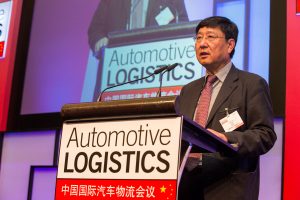 Cai Jin of CFLP pointed to a long-term trend of lower logistics cost relative to GDP in China
Cai Jin of CFLP pointed to a long-term trend of lower logistics cost relative to GDP in ChinaBut while those potentially radical changes could become more important as more OEMs build electric vehicles in China, in the short-term at least the trend seems to be towards managing more volume, diversity and complexity around inbound and outbound deliveries. And that would suggest a significant opportunity for providers and suppliers in China to add value.
[sta_anchor id="2"]A delightful year…in the endChina’s economy has stabilised and vehicle production volumes will beat the GDP growth rate in China this year, according to Cai Jin, vice-president of the China Federation of Purchasing and Logistics (CFLP). Importantly logistics costs have also been brought down over the longer term – in 2016 they amounted to 14.9% of GDP, which was lower than in 2005, when it was 16%. That drop has continued in the first quarter of this year according to Cai – although the level still remains well above those in developed markets across Japan, Europe and North America.
The strong growth in vehicle sales and production was “pretty amazing” and “delightful for the automotive industry”, as far as Xiao Zhengsan, general secretary of the China Automobile Dealers Association, was concerned.
Passenger vehicles reached 24.36m, of which around 72% were small-engine cars below 1.6 litres, according to Xiao. However, that share was largely supported by a tax incentives for smaller cars that is being withdrawn; otherwise, China saw blistering growth in crossover and SUV sales.
The increase in sales in China came in the second part of 2016 and caught many by surprise according to Bo Shiju, chairman of Changjiu Group, one of China’s biggest automotive logistics providers.
“In the second part of last year there was a sharp increase in sales volume and we were under great pressure,” he said, indicating that so were the OEMs and dealers.
The sudden increase also followed a period of low growth in 2014-2015.
“Last year was a release of energy that had been saved up over five years,” said Xiao Zhengsan. “It was a really, really good year – the dealers had a better profit in 2016 versus 2015.”
However, inventory at the dealers has grown since January, and dealer optimism is lower, as are the tax cuts for smaller vehicles; that has led to a more cautious outlook for 2017.
According to the China Association of Automobile Manufacturers, first quarter sales were so far up just 1% compared to the same period in 2016; the association expects sales and production in 2017 to rise 5%.
[sta_anchor id="3"]Learning the new rules of the game For many across the automotive supply chain, one of the biggest immediate hurdles to meeting current and future Chinese vehicle demand is an ongoing change in regulation for trucks and loading, including new specific rules for car carriers.
Known as the GB1589 regulation, the new rules are being phased in across several steps, before final implementation will be enforced from August 2018.
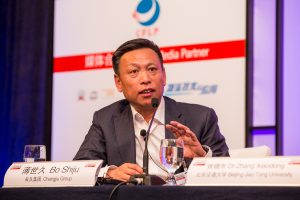 Changjiu's Bo Shiju said China should revise its new truck standard to allow for more height for loaded car carriers
Changjiu's Bo Shiju said China should revise its new truck standard to allow for more height for loaded car carriersWhile the restricted length and loading requirements are already leading to capacity challenges and pushing more OEMs and logistics providers to explore multimodal services, there is also debate and uncertainty about some of the requirements. Most notably, from August next year the wording of the new rules stipulates that a loaded trailer of cars must be no higher than 4 metres.
According to some at the conference, that will not allow companies to load trucks to full height. Some suggested that a height restriction of 4.2 metres is more realistic for a car carrier. However, Bo Shiju suggested that even that would not be enough.
“When the truck is fully loaded the height is about 4.4 metres,” he said. “That exceeds the statutory limit but Chinese regulations said that the limit of the height is applied to the loaded vehicle itself. I don’t think pushing the height to 4.2 metres can help solve the problems. We are still willing to negotiate with the authorities [but] our point of view is that the height limit should go to 4.5 metres.”
Zhang Xiaodong, professor of traffic and transportation at Beijing Jiao Tong University and an expert on transport policy who consults often with the government, also said there were issues related to the GB1589 regulation that affected how the carriers would cope with the different types of vehicles coming onto the market and how this would work out in terms of connecting volumes transported by road with other modes. Nevertheless, he said the regulation should be strictly enforced on its introduction to avoid confusion on the part of the driver.
[sta_anchor id="4"]On the multimodal path to progressDespite challenges in navigating regulatory changes, market unpredictability and a lack of standardisation, there are many signs of progress in multimodal logistics for the Chinese automotive industry.
The adoption of transport modes other than road, including inland waterway and rail, is a priority for the industry and the government alike, according to professor Zhang. As many as 18 different government agencies have been discussing the issue, he said, and the government has already run 16 pilot projects.
While many executives and experts express a desire to see more investment in rail water infrastructure or equipment, several carmakers have already developed alternative modes of transport for both finished vehicles and, to a lesser extent, for parts flows. This shift has in part been in response to the recent and ongoing changes to GB1589 – but also thanks to long-term strategies and investment.
BMW Brilliance, for example, BMW’s joint venture in China, which now builds more than 400,000 vehicles per year at its factories in Shenyang, in northern China, has made a remarkable shift to multimodal transport in just the past few years. Michael Tian, head of finished vehicle logistics at the carmaker, revealed that more than 50% of its vehicles now move by coastal, short-sea shipping, leaving from the port of Dalian to Shanghai and Guangzhou in the south.
Last year, the carmaker started shipping vehicles from Dalian uses ro-ro services by Chinese logistics provider Changjiu Group, a company in the process of expanding its ro-ro fleet to four ships this year, and 14 next year, according to Bo Shiju.
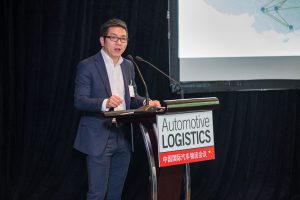 Michael Tian has led a multimodal push at BMW Brilliance
Michael Tian has led a multimodal push at BMW BrillianceFurthermore, thanks in part to the implementation of distribution centres both at the three ports and inland locations in Xi’an and Chengdu, BMW Brilliance is also using rail transport from its plants to most of the hubs, from which point it uses trucking transport. By later this year, he expected around 60% of vehicles leaving the plant to move by rail. “Rail has become more reliable and efficient for us,” said Tian (read more about BMW Brilliance’s multimodal strategy).
Other carmakers are also turning to water transport. Carmakers based in western cities along the Yangtze River, including Changan Ford in Chongqing or Dongfeng joint ventures in Wuhan, have long relied on it for moving vehicles and some parts. According to Ödling, Volvo Cars has also started to use barge transport to move materials between suppliers in Shanghai to its plant in Chengdu.
Chery Jaguar Land Rover (CJLR), which already uses river barge for inbound material flows from Europe, has recently implemented a distribution hub in Chongqing, where it stores vehicles for final distribution that arrive via river barge transport from its plant in Changshu, north of Shanghai, according to Rui Zhu, director of materials and logistics.
He pointed out river transport was 50% the cost of moving vehicles by road and offered savings elsewhere in terms of freeing up truck assets to collect more cars and acting as a storage option for incoming vehicles, which has helped keep the size of the distribution centre to a minimum.
“Our inventory is safe for one week and we can put this on ships roaming on the Yangtze River,” he pointed out. “I don’t have to rent an extra 30k sq.m of warehouse space to keep the inventory safe.”
Taken together, Zhu said using inland waterways amounted to savings to CJLR’s western region of around RMB 6m ($870,000) per year compared to road.
He also said that the carmaker has conducted a market survey looking at four different options involving mixes of road and coastal shipping that involved distribution centres in Tianjin and Shandong in the north. According to Zhu, the company is currently looking favourably on a combination of direct road deliveries and a combination of road and inland water routes.
[sta_anchor id="5"]Rail potentialWhile BMW Brilliance has perhaps made the most progress in using rail, others, including Zhu at CJRL, said the infrastructure was still too limited for the carmaker to use it. Ödling also said that Chinese rail services were not stable enough to use for inbound logistics flows. Professor Zhang Xiaodong commented that connections between rail and other transport modes were often lacking in China.
However, Zhang pointed to solid growth in moving finished vehicles by rail in China, as the state rail operator moved 2.9m vehicles in 2016, and is increasing capacity to move as many as 5m this year.
Meanwhile, there has also been an expansion in the use of the China-Europe railway, with the rise of various express services. Zhang said that China Railways moved 1,700 trains in 2016, including 570 from Europe to China (another 300 trains were run by other operators).
By 2020, the number of trains between Europe and China is expected to reach 5,000, said Zhang, with considerable investment in automotive hubs both within China and across other countries along the route in central Asia, Russia and Europe.
Zhu also pointed to the option of rail and his previous experience at BMW Brilliance, which ran the first express rail service between Germany and Shenyang for parts movements.
“When I went to CJLR I was thinking how to introduce the rail model to the new company because my experience with BMW was successful and would add flexibility for the OEM because it was faster than ocean and less expensive than airfreight,” Zhu said.
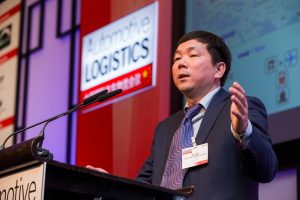 Rui Zhu revealed how Chery Jaguar Land Rover had saved money by switching to river transport to serve western China
Rui Zhu revealed how Chery Jaguar Land Rover had saved money by switching to river transport to serve western ChinaAccording to Zhu, CJLR is considering a range of options for using the China-Europe rail link, including for parts and finished vehicles.
Ödling said Volvo Cars has also used the China-Europe rail service “quite often” to import parts and vehicles, even if it is not yet using the service on a regular basis.
Meanwhile, Volvo is expected to start moving exports of Chinese-built Volvos to Europe, perhaps as early as this year. Further details are expected in the coming weeks.
[sta_anchor id="6"]China as a global export centreBeyond intermodal flows, China is also starting to see a shift towards production of vehicles for global export, both from its domestic and joint venture carmakers. Most notably, GM has started imports in small volume of some Buick and Cadillac models to the US from China, while Geely-owned Volvo Cars has already started exporting to the US from China – with plans to increase models and volumes globally, including to Europe.
The number of exports does not reflect the progress insomuch as the destinations, at least for some brands. According to Wu Songquan, director at the Auto Industry Policy Research division of the China Automotive Technology and Research Centre (CATRC), last year China exported 700,000 vehicles, the same amount as in 2015 but substantially below the 1m mark that it passed in 2012. Likewise, spare parts exports were down on last year by 2.8%, though the value of parts exported still amounted to $6.45m, with the US the biggest market accounting for 26% of the total.
The largest exporters include Chery, SAIC and Shanghai GM, though a large number of plants in China export in small numbers.
 Wu Songquan at the Auto Industry Policy Research division of the China Automotive Technology and Research Centre warned that protectionism could hurt Chinese OEMs
Wu Songquan at the Auto Industry Policy Research division of the China Automotive Technology and Research Centre warned that protectionism could hurt Chinese OEMsWu said that there were challenges to continued international trade, with impediments to export growth coming in the form of political turmoil in a number of regions, an increase in anti-globalisation and a restructuring in global trade. Wu also pointed to political changes in the US and Europe, including the election of Donald Trump as president and the decision of the UK to leave the EU.
Brexit could affect business strategy decisions at China’s OEMs and suppliers, he pointed out, “especially the domestic [Chinese] companies’ expansion plans in Europe”. However, Wu said that there was still scope to recover the trade advantages China had with UK as a part of the EU.
“[Despite] Brexit there are still some possibilities of renegotiating the zero tariff policies for the relevant parties,” said Wu. “But whether it is relevant to recover the past practices it is open to anyone’s guess. Some other possibilities may include renegotiations over trade between China and the UK and China and the EU respectively.”
Overall, however, he was confident in the long-term prospects for China as a global finished vehicle exporter to both developed and emerging world markets.
[sta_anchor id="7"]Focusing on quality exportsNevertheless the export outlook is optimistic according to Xu Changming, vice-president of the State Information Centre, who said China had had to improve quality on the domestic market first before exporting abroad.
“You have to do well in the Chinese market first; if you don’t do that, it is difficult to go out of China,” said Xu, citing previous problems with exports to Iran. He said he expected it would take another two-to-three years before vehicle exports really became large scale but said he was optimistic.
A good example of that is seen at Volvo Cars, owned by Geely since 2010, which became the first carmaker to build a premium car for export to the US, shipping a version of the S60 from its plant in Chengdu.
The carmaker has also revealed that it will eventually make its plant in Daqing, in northern China, the single global source for the S90, with plans to export it globally.
A new plant that will come online in Luqiao, south of Shanghai, will also build S40 products as well as cars on the same platform for Geely’s new brand, Lynk & Co, which will also be exported globally, including to the US and Europe by 2019. The Luqiao plant is owned by Geely but will be operated by Volvo Cars. This plant is also expected to build the carmaker's first electric vehicle.
“Producing for global exports will introduce more complexity into our inbound logistics as it will add more variables and derivatives,” said Magnus Ödling. “It will also put more pressure on our supply and demand planning.”
SGM has also shipped Buick models to the US for export, while some analysts expect other Chinese brands to increase vehicle exports to more western markets. Xu Changming suggested that growing market share and quality within China among several local brands, including Geely, Great Wall and Chery, should help these brands to launch exports to mature markets – with high-value logistics an important part of the offering.
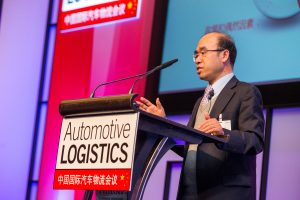 Xu Changming of the State Information Centre was optimistic about sales and exports of Chinese brands
Xu Changming of the State Information Centre was optimistic about sales and exports of Chinese brands“Earlier attempts at export were focused only on cheap products, with no real concern for aftermarket. Imported parts could take months to get to customers, and so service will be important to future exports,” said Xu. “I predict it will taken another two or three years, but Chinese brands will start to launch more exports.”
Hu Siyu, an independent automotive consultant, formerly of Sinotech Automobile, added that while China has not historically been strong on the quality of its vehicle manufacturing, the growth of exports to international markets indicated that there had been an improvement. That has been helped by the presence of joint venture OEMs and changes to the law on vehicle exports.
“Thirty years ago when the domestic OEMs signed joint venture contracts with foreign international carmakers the vehicles made by those companies were not allowed to be exported,” she said. “But now things have changed and the import/export market is a helpful supplement to the domestic business.”
Free trade agreements (FTAs) were also important to the development of China’s export trade in vehicles (as they are for imports). Wu indicated that China had signed 15 FTAs covering 22 countries and that nine of them were now in play, including the Regional Comprehensive Economic Partnership (RCEP) between the ten ASEAN member states and six countries that currently have independent agreements with them: Australia, China, India, Japan, South Korea and New Zealand.
Xu Changming pointed to other economic liberalisation that could impact exports. For example, he said that Chinese exports among western brands would likely take off should the Chinese government loosen its current rules for automotive manufacturing, which requires foreign companies to own no more than 50% of local operations in China. As a result, most joint ventures remained focused on the Chinese domestic market.
[sta_anchor id="8"]Global imports and policyWhen it comes to vehicle imports to China, the trend is on the decline, with the type of car imported biased toward the premium segment. Vehicle imports, which were around 1m last year, accounted for only about 3.8% of sales in 2016 according to figures from CATRC. This is expected to drop by 100,000 by 2020.
The top three countries importing passenger cars to China are Japan (285,000), the US (250,000) and Germany (224,000). The top carmakers exporting to the country are BMW, Mercedes-Benz, Toyota, Porsche and Jaguar Land Rover.
Government policies and taxation have a big impact on vehicle imports, and free trade agreements influence tariff levels. Wu Songquan pointed to China’s policy on consumption tax, which changed this year, by way of example. That tax is paid by whoever sells the vehicle so if a vehicle is worth 1.3m RMB, 130,000 RMB will be added as a consumption tax.
Importing carmakers must also adhere to strict fuel consumption regulations according to Wu.
“There are very strict regulations on fuel efficiency,” he said. “Last year the industrial average was 6.8 litres per 100kms and that standard will continue to rise, which puts a lot of pressure on both domestic and imported vehicles.”
Amongst the importing carmakers that did not meet China’s fuel efficiency standards last year were Ford, Jaguar Land Rover, Mitsubishi and Nissan, according to figures from the Ministry of Information.
“There will probably be more failing in the future as the standards tighten further,” said Wu.
Another policy that has a big influence on imported vehicles relates to ‘parallel imports’ – those vehicles imported outside official OEM channels.
 Hu Siyu, independent automotive consultant (formerly of Sinotech Automobile), said that parallel imports of vehicles reached 250,000 units last year
Hu Siyu, independent automotive consultant (formerly of Sinotech Automobile), said that parallel imports of vehicles reached 250,000 units last yearThe number of parallel imports to China is rising as the overall import volume drops and becomes more exclusively premium sector. Hu Siyu said that the total number of parallel imports is usually around 130,000-150,000 vehicles, though last year it spiked to around 230,000 vehicles.
While parallel imports received criticism from certain parts of the automotive sector, Hu put the market in perspective. “Many people still tend to demonise parallel imports…[but] it is by no means the biggest market,” she said.
She added that the decline in imports through official channels was not to do with a rise in parallel imports. “Demand is increasing in fact, influenced by generational shift and mass public appeal. All these imports will cater to a certain segment.”
[sta_anchor id="9"]Globally competitive logisticsAs well as prospects for growth in exports and imports, Chinese carmakers and logistics providers are also firmly on the path to more advanced services and operations. SGM’s Ni Bin pointed to the use of AGVs in warehouses, and revealed plans to use a tracking system for all parts in plants and warehouses. He also said that the carmaker had started to use virtual reality to simulate material flow and check risk in different parts flow and patterns.
Changjiu’s Bo Shiju, meanwhile, said that the company was continuing its push to expand both its service offerings in China and globally. The carmaker, which was the first automotive logistics company listed on the Shanghai stock market last August, is investing significantly in ro-ro vessels and exploring rail services. Since launching a German subsidiary in 2014, it has also been pushing into new markets.
“We want to go global, and we are looking for opportunities through mergers and acquisitions to accelerate this,” said Bo.
CFLP’s Ma Zengrong noted that Chinese automotive logistics providers had in many cases caught up to or were close behind their global counterparts in terms of quality and processes, including in IT systems, multimodal transport and areas like returnable packaging. He suggested that most global companies operated in China would likely benefit most by partnering with local players, while local players would turn to their international counterparts to help expand in new markets.
“Partnership and cooperation between Chinese and global logistics providers is the path to a good future,” he said.
While not every executive would agree that Chinese automotive logistics was at the highest global levels – logistics as a share of total costs is still typically higher, while equipment standards and quality can still lag – there was little doubt among most executives that China remains on a highly positive path of development.
Automotive Logistics China is part of the global Automotive Logistics series of conferences
The next conference is the Automotive Logistics Supply Chain Conference in Atlanta, US on May 8th-10th.
Topics
- Asia
- Asia Pacific
- Chery
- China
- China
- Electric Vehicles
- features
- Finished Vehicle Logistics
- Geely
- GM
- Govt policy/regulation
- Inbound
- Inbound Logistics
- Integrated LSPs
- Intermodal
- Inventory management
- multimodal
- Nissan
- OEMs
- OEMs
- outbound
- ports and terminals
- Road
- Road
- Shipping - vehicles
- Suppliers
- supply chain management
- Supply Chain Planning
- Tier suppliers
- trailers
- Trucking
- Volvo Cars






























